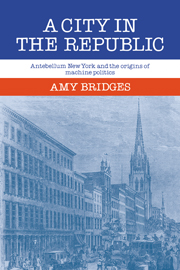Book contents
2 - THE CHRONICLES OF PARTY
Published online by Cambridge University Press: 07 October 2011
Summary
Between the election of Jackson and the election of Lincoln, New York's political life underwent several transformations of party competition and political argument. Party conflict was organized, disorganized, and reorganized. Ideological debate and political rhetoric ranged over issues as diverse as alcohol and banks. The stories of party combat and of ideological debate are of course related, for parties are the most vigorous and consistent purveyors of visions of society. This chapter traces party contests at the polls and the visions they presented.
The chronology of party combat is shown in Figure 1. Until 1852, Whigs and Democrats, the parties of the second American party system, dominated local political life. Nativist parties made a brief appearance in the mid-1830s and were a more important presence in the mid-1840s and again in the mid-1850s. After the collapse of the Whigs, New York's politics involved a profusion of factions and parties vying for local control as a means to national ascendancy. More importantly, in the middle of the 1850s the characteristic urban competition of boss and reformer appeared. If the transformations of antebellum political life were complex, their direction was clear: By the time Abraham Lincoln was elected, New York had a distinctively urban and autonomous political system. Local politics, moreover, was more salient than in earlier years. Figure 2 shows that turnout in mayoral elections was much closer to turnout for presidential elections in the last decade of the antebellum era than in the Age of Jackson.
- Type
- Chapter
- Information
- A City in the RepublicAntebellum New York and the Origins of Machine Politics, pp. 18 - 38Publisher: Cambridge University PressPrint publication year: 1984



